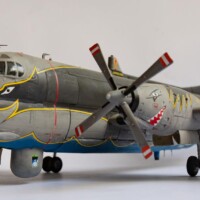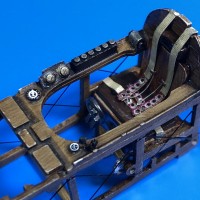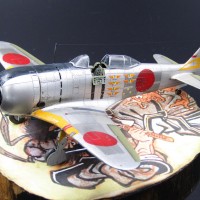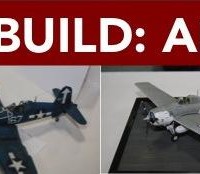Review: Eduard 1/48 P-51B/C (w/dorsal fin) – Li'l Kitten of the 357th FG
The Airplane:
During September, 1943, rumors abounded among pilots in the fighter groups regarding things to come. Word of the first flight of the P-51B in Los Angeles spread through the world of Air Force fighter pilots like wildfire. When Chesley Peterson returned to take command of the 4th Fighter Group, he told the pilots there was a new airplane in the works. Steve Pisanos recalled him saying, “They're coming up with a new fighter that will be far superior to he P-38 and P-47, a kite that can be used for long-range escort.” That rumor became reality on September 26, 1943, when Pisanos returned from escorting B-17s in northern France. “I taxied into the dispersal area only to find a P-51 Mustang with a four-bladed propeller parked on the grass across from my stall.” Pisanos was familiar with the Allison-powered RAF Mustang I, having flown one for 40 hours in OTU training and then another 40 operational hours with 268 Squadron before he came to 71 Eagle Squadron. He met the pilot, Captain Jack Miller from VIII Fighter Command staff. “He told me it was equipped with a Merlin engine and that it was on loan to our group for the pilots to fly and evaluate it.”
There was universal dismay in VIII Fighter Command when it was learned the new 354th group - assigned to IX Tactical Air Command! - would be first to get the new Mustang. The problem was in the Pentagon; to officers in Materiel Command who had no knowledge of operational reality, the Merlin-powered Mustang was declared a “tactical fighter” because both the RAF and USAAF had decided the earlier, Allison-powered Mustangs would be used in tactical roles. The decision to send the Mustang to the Ninth Air Force was based on bureaucratic precedent, if it was based on anything. When the 363rd group - also in IX TAC - was named number two and the newly-arrived 357th group was given the P-51B and also assigned to IX TAC, a political earthquake happened at Pine Tree, VIII Air Force HQ.
VIII Fighter Command's General Kepner immediately protested that the Mustang, with a vulnerable liquid-cooled engine and a radiator that only needed one minor-caliber hit to be put out of action, was exactly what was not needed in a ground support mission. For VIII Fighter Command, the P-51B was the solution to the problem they had faced since the command first began flying missions - with two drop tanks, a P-51B could reach Berlin, and tests between P-51Bs and captured Bf-109s and Fw-190s demonstrated the Mustang was competitive in ways the P-47 would never be.
One of the first decisions General Dwight Eisenhower made after his arrival in England as Supreme Commander, Allied Expeditionary Forces (SHEAF), was to transfer the 357th to VIII Fighter Command, while IX TAC got the P-47-equipped 358th Fighter Group. All further P-51Bs arriving in Europe would re-equip VIII FC groups. It was a decision that changed the air war and insured the Normandy Invasion would happen.
The 357th Fighter Group had started sending pilots to fly missions with the 354th group after they received all 48 P-51Bs assigned to the group and the pilots were checked out in them by mid-January. On January 14, group commander Colonel Chickering, with squadron commanders Majors Don Graham and Hubert Egenes flew with 40 other 354th group Mustangs led by Major Bickell, escorting 552 bombers to the Pas de Calais area on one of the first missions to bomb launch sites being built for the V-1 cruise missile.
On February 1, 1944, the trade between Eighth and Ninth Air Forces was official, and the 357th became the first VIII Fighter Command Mustang-equipped group, while the P-47-equipped 358th group went to IX Tactical Air Command. The two groups also exchanged bases, with the 357th moving to Station F-373, located between the villages of Leiston, Saxmundham, and Theberton. While the base was officially named Leiston, Nazi propaganda broadcaster “Lord Haw-Haw” chose the name of a village further from the field than the others, using it to name the new group “The Yoxford Boys” during an evening radio program. As an impudent reply to the Nazis, the 357th soon adopted this as their group name.
Li'l Kitten:
P-51C 42-25039 was delivered to the 357th in April 1944, arriving in the new unpainted aluminum scheme. The airplane went through the group's paint shop, where it was painted with RAF Dark Green and Medium Sea Grey and given the ETO ID markings. A shipment of Malcolm hoods had recently arrived, and the airplane had its “coffin lid” canopy replaced. Flown by several different pilots in the leadup to the Normandy invasion; at one point it came back from a mission and made a forced landing on the grass at Leiston, suffering damage to the landing gear doors, radiator intake, and the housing. Replacement items were taken from another older Mustang and the now-old fighter was additionally “modernized” with the dorsal fin, which gave added stability. It was assigned to newly-arrived 2nd Lieutenant Louis Fecher, who flew the airplane through the fall of 1944, when it was finally declared “war weary” and sent on to the group's “clobber college” to train new replacements.
The Kit:
Eduard's announcement last fall that they would produce a P-51B/C kit to the same quality level as their outstanding P-51D series electrified the hobby.
Eduard fulfilled its promise. Their new kit is definitive.
Those familiar with the Tamiya P-51B will be surprised to find out how many detail parts there are in the new kit, including the first accurate portrayal of the Malcolm Hood and its fittings. The cockpit - a real failure in the Tamiya kit - is completely accurate. Surface detail is the equal of the P-51D. Importantly, Eduard learned from the D-model kits and has changed certain parts to get rid of the earlier “fiddliness” of the D models - most particularly, the attachment of wing subassembly to fuselage subassembly has been simplified and the two come together without problems.
Eduard has already released several other Limited Release Profipack kits since the initial release last Spring. This second major release comes with the dorsal fin extension that was fitted to P-51B/C Mustangs as a field modification. This has only appeared in kit form before with the P-51C release by Accurate Miniatures 25 years ago.
Construction:
This is definitely a kit where you will want to study and then follow the instructions. This is particularly the case with the cockpit assembly.
After several aborted frustrating attempts here, I ended up taking the cockpit side panels off and attaching them to the cockpit floor after the seat, tank, radios and other gear had been installed. This is because the one “fiddly” item of assembly is getting the main cockpit assembly to fit as needed to the side panels. Once I did this, everything came together easily and the deep purple atmosphere over the workbench quickly dissipated. The rest of the fuselage assembly came together the same way the P-51D kit does.
The wing assembles the same as the P-51D wing, with the exception that you do not need to attach the “roof” of the wheel well to the bottom of the cockpit floor and cut off the pesky attachment tang that gets in the way of an easy assembly of the D-model kit.
The wing sub-assembly and fuselage sub-assembly came together without even a slight problem. Be sure to study the instructions for the wing and insure you get all the new detail parts assembled correctly.
The kit provides both the “coffin lid” canopy with open and closed options, as well as the Malcom Hood, also with open and closed options.
An afternoon's effort saw the kit assembled. I let it set up overnight and proceeded to paint it.
Painting:
I chose to do “Li'l Kitten” which was on the new Bullseyes Decals sheet “Yoxford Boys #7", 48-036. Scott Brown is working his way through every 357th P-51 for which there is a good photo for reference. The Bullseye sheets are all extremely well-researched and printed by Cartograf. Since many of the group's airplanes were fully-camouflaged, they're a good subject for those modelers who don't want to do a NMF finish.
Fortunately, I had a well-known color photo of this airplane. Close study allowed me to spot the NMF intake scoop and the areas on the radiator housing where paint was rubbed off by the wheels-up landing, as well as the replacement gear doors.
I first painted the spinner and forward fuselage and rudder yellow, then masked that off. I proceeded to “pre-shadow” the model with flat black airbrushed over the panel lines. I then maked off the “D-Day” stripes on the radiator housing and painted that area white, along with the areas for the ID stripes on the wings and horizontal stabilizers, which I then masked off. I painted the camouflage with Tamiya lacquer “Dark Green 2" (LP-56) and Tamiya acrylic RAF Medium Sea Gray (XF-83).
Final assembly:
I attached the landing gear, and the Malcolm Hood in the closed position and called things completed.
Overall:
Eduard's P-51B/C kits are the best early-Merlin Mustang kits in 1/48, and are only equaled by the Arms kits in 1/72. (Eduard will release the kit in 1/72 lat er this year) I like this kit as much as I like Eduard's P-51Ds. There will definitely be more of these great kits ending up as models in my collection. Recommended for modelers willing to take the revolutionary step of actually following the instructions, since they are not “somebody's opinion.”
















A very interesting account. I wasn't aware of the origin of 'The Yoxford Boys'. Nice work and very impressive looking model.
Another thorough review and an interesting history to go with it.
Excellent result and ditto article, Tom!
Excellent post. I've been looking forward to their B/C model.
G’day Tom (@tcinla),
A great build, as usual.
Nice Mustang, Tom. That particular plane is one I’ve never seen before.
This is a wonderful early Mustang, Tom @tcinla
Very informative and nice to read article, thanks for that.
As usual, a great history report and build. Well done, Tom.
Very nice job as usual and the history really helps folks understand what VIII Fighter Command was dealing with...between the Germans and Washington. I'm glad Eduard "fixed" the wing floor/floor issue. They have been pretty good at re-engineering problem areas for new releases. I wish they would do a re-pop of their Fw 190-D with and improve the forward fuselage/engine structure. Stay safe from the fires...
Nicely done! I'm putting together a Hasegawa B now, and since the fastback ponies are my favorite, I'm looking forward to Eduard's 1/72 output of this one! I like the scheme on this.
Reads and Looks great, Tom. Really appreciate the tip about the cockpit walls. Does this apply to the B kit?
Great job Tom...can't wait to build one